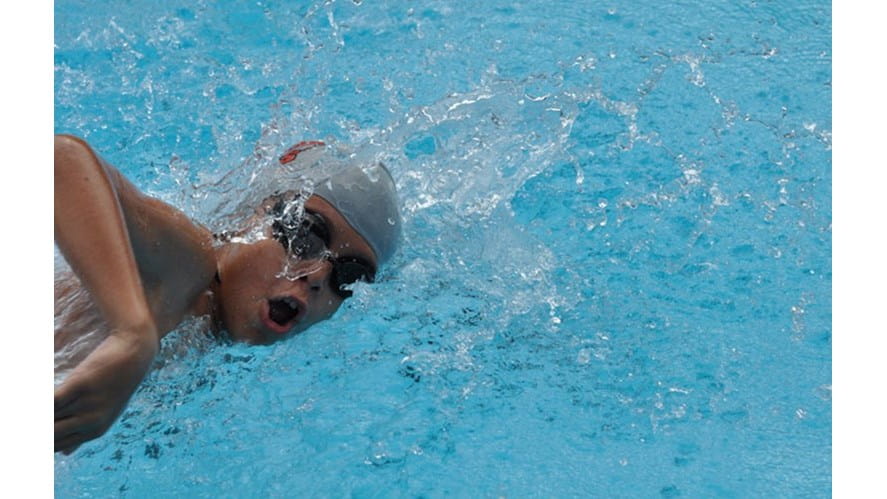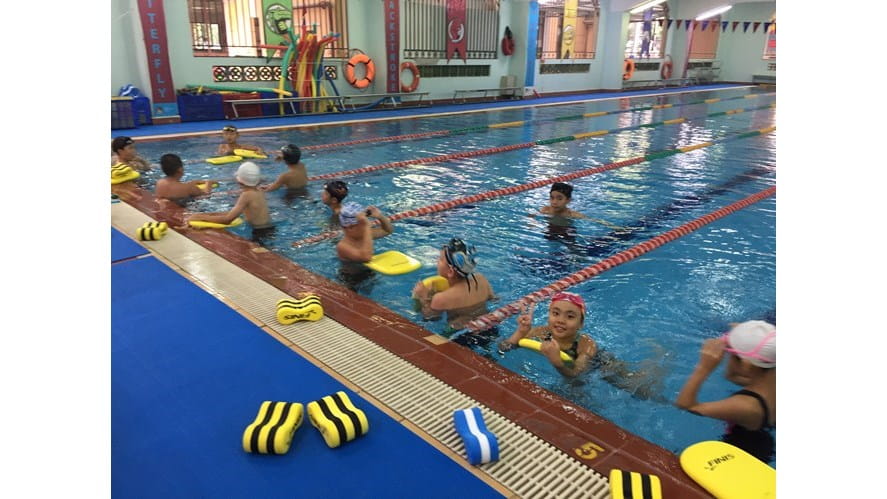The importance of learning to swim During Term 2 and Term 3 all students from F3 – Year 6 will participate in swimming as part of their PE program.
During Term 2 and Term 3 all students from F3 – Year 6 will participate in swimming as part of their PE program.

During Term 2 and Term 3 all students from F3 – Year 6 will participate in swimming as part of their PE program. Swimming is an integral life skill which allows individuals to participate in water activities for the duration of their lifespan. With knowledge about water safety and the ability to swim an individual can do many activities such as; surfing, water polo, body surfing, canoeing, diving, snorkeling, swimming for recreation, competitive swimming, water skiing, wakeboarding, underwater hockey and many more! It is an important skill, which we at BIS feel will enrich all the lives of our students and families.
Swimming also has many health benefits such as increased cardiovascular fitness, muscular strength, bone density, coordination and flexibility. Most importantly it positively impacts an individual’s well-being by providing a fun environment to enjoy with friends and family.
Whilst water activities are a great way to have fun, they can also pose a significant risk for those who do not understand the hazards and safety precautions in and around water. In Vietnam, the Ministry of Health reports that 16 people drown every day in Vietnam. This is 10 times that of other countries. Vietnam is a country with many waterways and coastal regions and the leading cause of death of children within Vietnam is drowning.
The BIS Physical Education department is committed to teaching students how to swim, but more importantly developing their understanding of water safety. Each student within their lesson will be in a group which develops water safety and swimming ability relevant to their needs, rather than their age. This term we will introduce the BIS Swimming Levels (please see below).
As a parent, there are a few things you can do to ensure you and your child are safe when taking part in water activities.
- Learn CPR
- Always actively supervise your child when they are playing in water
- Develop your own swimming ability (Paul Sadler Swimland offers adult swimming lessons)
- When swimming at a beach or open water ways, read signs carefully
- Never swim alone
To ensure your child can achieve the most out of the swimming program please ensure they come to lessons prepared with their BIS swim suit and a towel. Children are encouraged to wear goggles and a swimming cap. Students will only be excused from swimming if they have a doctor’s note outlining why they cannot participate. As outlined in the Physical Education Policy, if they are well enough to be at school, they are well enough to participate.
BIS Swimming Levels
LEVEL | SWIMMING AND MOVEMENT | WATER SAFETY |
1 | - Enter and exit water safely and confidently. Waits until instructed.
- Blows bubbles with face submerged in the water
- Front float with assistance, face in blowing bubbles, recover to standing
- Back float, with assistance, recover to standing
- Push and glide with buoyancy aid
- Push and glide without buoyancy aid (torpedo) (can be assisted)
| - Wade in and slide in entry
- Safe exit (elbow, elbow, knee, knee)
- Signal for help
- Be pulled to safety by grasping a rescue aid
- Collect submerged object with or without assistance
- Can answer age related safety questions
|
2 | - Slide in entry
- Front push and glide with kickboard, face in, hold for 3 seconds
- Back push and glide with board on chest, hold for 3 seconds
- Front torpedo, with or without assistance, face in water blowing bubbles, kicking 5m
- Deep water, demonstrate basic treading water and arm sculling to support body in an upright position
- Freestyle kicking with and without buoyancy aid, face in blowing bubbles
- Backstroke kicking with and without buoyancy aid
| - Wade in and slide in entry
- Safe exit (elbow, elbow, knee, knee)
- Signal for help
- Be pulled to safety with a rope for 5m
- Collect submerged object from hip deep water with or without assistance
- Accidental fall in – tread water
- Can answer age related safety questions
|
3 | - Front torpedo with a board, face in blowing bubbles
- Back torpedo with a board
- Front torpedo without a board, face in blowing bubbles
- Back torpedo without a board
- Demonstrate basic single arm freestyle with board
- Demonstrate basic back paddle in a horizontal position
- Demonstrate a sitting dive
- Introduce survival backstroke kick
- Introduce butterfly kick
| - Wade in and slide in entry
- Safe exit
- Accidental fall in, float and swim to edge
- Reach rescue with a rigid aid
- Answer age related safety questions
|
4 | - Demonstrate freestyle with alternative arm action
- Demonstrate freestyle with side breathing
- Demonstrate backstroke with continuous alternative arm action
- Demonstrate basic survival backstroke with a kickboard
- Demonstrate a kneeling dive
- Demonstrate dolphin kick for 5m
- Demonstrate a kneeling dive
- Introduce breaststroke kick
| - Wade in and slide in entry
- Compact jump and stride in entry
- Fit a life jacket whilst in the water
- Throw rescues
- Survival sculling for 30 seconds
- Floating for 1 minute with or without an aid
- Can answer age related safety questions
|
5 | - Swim 10m freestyle with side breathing
- Swim 10m backstroke with efficient body position
- Demonstrate butterfly kick with or without a board for 10m
- Demonstrate survival backstroke
- Demonstrate breaststroke kick 10m (symmetrical)
- Introduce breaststroke arm action and timing
- Demonstrate a standing dive
| - Demonstrate a range of safety entries relevant to water safety scenarios
- Fit a life jacket whilst in the water
- Survival sculling for 30 seconds
- Floating for 1 minute without an aid
- Can answer age related safety questions
- Introduce sidestroke
|
6 | - Swim 25m freestyle with side breathing
- Swim 25m backstroke with continuous arm action
- Swim 25m survival backstroke
- Demonstrate breaststroke with correct timing
- Demonstrate basic butterfly arms
- Introduce forward somersault in the water
- Introduce backward somersault in the water
- Swim continuously for 200m
| - Collect object from deep water
- Demonstrate side stroke
- Introduce accompanied rescue and non-contact tows
- Can answer age related water safety questions
- Survival scenario – dressed in long pants and long sleeve top
- Sculling, floating or treading water for 3 minutes
- Perform feet first surface dive and swim underwater for a short distance
- Swim for 4 minutes using survival strokes
- Correctly fit a PFD, enter water using a compact jump, float for 30 seconds
|
7 | - Swim 50m freestyle using efficient technique
- Swim 50m backstroke using efficient technique
- Swim 50m breaststroke using efficient technique
- Swim 25m butterfly
- Demonstrate forward somersault in the water
- Demonstrate backward somersault in the water
- Swim continuously for 300m
| - Can answer age related water safety questions
- Demonstrate rescue throw, tows and entries.
- Survival scenario – dressed in long pants, long sleeve and jumper
- Enter water using feet first entry
- Submerge feet first, swim underwater on back looking up at the surface
- Swim 50m fast to escape dangerous situation
- Float using a buoyant aid for 1 min
- Swim for 6 minutes using survival strokes
- Scull, float and tread water for 3 minutes. Remove clothing.
- Correctly fit a PFD in the water, swim 50m using survival strokes
|
8 | - Demonstrate tumble turns
- Demonstrate touch turns
- Swim 100m freestyle using efficient technique
- Swim 100m backstroke using efficient technique
- Swim 100m breaststroke using efficient technique
- Swim 50m butterfly using efficient technique
- Swim continuously for 400m
| - Can answer age related water safety questions
- Demonstrate rescue throw, tows and entries.
- Survival scenarios – dressed in long pants, long sleeve, jumper, socks and shoes
- Dive and swim underwater
- Remove shoes whilst treading water
- Swim 50m breaststroke
- Float, scull and tread water for 5 minutes. Wave for help.
- Swim 200m survival strokes, changing every 50m
- Remove clothing in deep water
- Fit PFD whilst treading water, swim 100m survival strokes, demonstrate HELP technique
|
If you have any further questions, please feel free to contact Head of Aquatics anytime on emily.mcclelland@bisvietnam.com.
Emily McClelland, Head of Aquatics







.jpg?h=667&iar=0&w=1000&rev=e9ca63bf8e4d449d9a9d3cea9f6158a5&hash=D43C4ED7C1708B4FDC96905CE2F68D6F)

